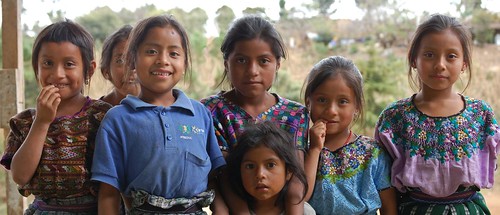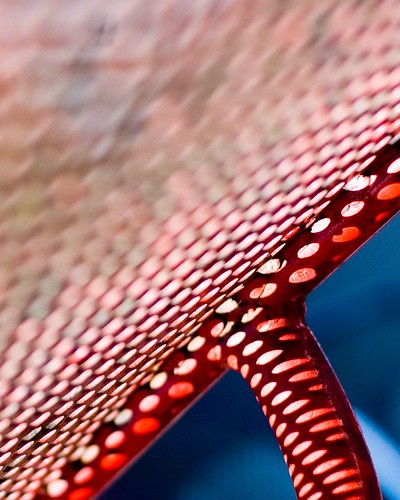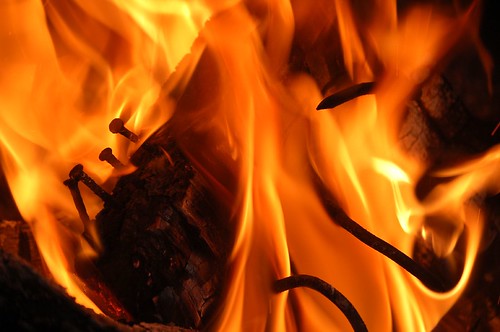
Originally, we had planned our vacation to be a whirlwind trip to Colorado and Boston for family time, and then just under a week in Panama. As silly as it sounds, we are allowed one trip for "R and R," which involves normal use of vacation time, but the State Department pays for one full-fare ticket for each of us to the nearest point of relief -- i.e. the nearest spot where we could enjoy an American-style standard of living for a little while. So if you're in Cambodia, they'll fly you to Australia. If you're in Africa, it's usually Europe. And for those of us in the less-developed spots of Latin America, we get a free ticket to Miami. Luckily, the key phrase is "full-fare," which means we can get a $900 ticket for the two hour flight to Miami, or use that much money for a flight elsewhere. Thus, we were going to do Guate-Denver-Boston-Panama-Guate and only pay a hundred bucks or so out of pocket.
And then Congress didn't pass the budget on time, which they never have since the days of Martin Van Buren. So, the arcane rules say we had to wait for them to release the December pile of money before we could buy our tickets home. Which meant we had to wait until three weeks before Christmas. The reader will not be shocked to hear that the prices get just a little higher when you wait that late. So we wound up paying just a hundred bucks or so out of pocket just to do the Colorado and Massachusetts legs of the trip, and then went under our own steam to Mexico.
The sliver of Mexico avaliable to us on a seven-day road trip from Guatemala City is not the most developed part of the country. We had ideas in our heads that we might get up early and with a couple long days of driving, go to the Yucatan or Oaxaca, or to see the Olmec remains in Tabasco. But a more realistic schedule limited us to Chiapas. We kept our expectations low -- surely Chiapas would be just like Guatemala, in geography, culture, and amenities.
How wrong we were! Upon crossing the border, the highway was in noticably better shape, cleaner, and (through no fault of the Guatemalans) straighter and flatter, as the sharpest (and prettiest) of the mountain ranges are on the Guatemalan side of the border. On the other hand, the Mexicans realize that you can drive fast on their roads, and have responded in kind with an extremely agressive speed bump program. Any populated stretch of the road -- which can apparently include a random shack five hundred yards off the shoulder -- merits at least two speed bumps, usually so big that even when driving as slow as humanly possible our poor little Nissan was guaranteed to scrape bottom. I'm mostly sure we didn't lose any parts that were actually critical to the operation of the car.
We decided that we couldn't risk hitting an unmarked speed bump at night, so before darkness fell we stopped in Comitán, a surprisingly quaint city celebrating its 500th anniversary. We checked into a charming
hotel room, and had a delicious meal of flavorful beer and even more flavorful food. It is an inexplicable tragedy for the people of Guatemala that the cultural meme responsible for
mole sauce never managed to permeate the border.
The next day, we decided to take what our bare-bones guidebook (purporting to cover all of Mexico and Central America) promised was a scenic route. The road surely would be lovely when not enveloped in fog. We made it through the
sugar-cane fields to Venustiano Carranza, a town claiming to be home of the marimba -- we decided not to mention this boast to anyone in Guatemala lest things get ugly. There were, in fact, quite nice views from the hilltop town. Maybe not really worth going a couple hours out of the way for, but such are the risks the road-tripper takes when allowing the wind to decide his direction. We passed through a couple other modestly interesting towns on the way, including one famous for their handmade giant ceramic chickens. So.
That afternoon, we reached
San Cristóbal de las Casas, at the heart of Chiapas. For those who have visited and are familiar with Antigua Guatemala (or just those who have seen
pictures of it),
San Cristobal (accent to be dispensed with in all further references) is like Antigua if it was still a real operating city rather than a carefully preserved colonial museum. I love Antigua, but it was fantastic to see actual Mexicans walking around the town (even if many of them were also tourists), and to have a selection of interesting bars, many of which happened to have live music on any given evening. In the end The Lovely Katherine and I decided that a large part of this was probably related to the average age of tourists in San Cristobal being about 15 years less than that of the average tourist in Guatemala. And although a distressing number of these young tourists were of the dreadlocks-and-tie-dye variety, we didn't hear any Grateful Dead cover bands, and avoided having any discussions with starry-eyed fellow travelers about the righteous struggle of the Zapatistas against The Man.
As we headed on to Palenque the next day, the full Zapatista scene came into sharper focus. Many towns or even cornfields would be marked with billboards declaring that locale "Zapatista Country." If we weren't more than a little scared of what kind of reaction a couple gringo tourists stopping to snap pictures would elicit, the staff photographer would have loved to snap some pictures of one local schoolhouse that was painted in a vibrant mural showing Subcomandante Marcos carrying AK-47s under rainbows and smiley-face suns. (There is a photo of one of the signs, but alas not the mural, on the
Wikipedia page on the Zapatistas - scroll down a bit.)
Along the way, we stopped at the Mayan ruin of
Toniná, which is not one of the more famous ruins, but was actually lovely. It is built on a hill, so from the temples at the top, the views are fantastic. And there was very little tourist hub-bub about, as it's a little off the beaten path. We arrived after dark in the town of Palenque, which basically came into being to cater to the tourist needs of visitors to the more famous Mayan ruins of the same name, and it looks the part. It did have plenty of opportunities to buy bootleg movies, or t-shirts with pictures of Mayan temples on them. But it's not all bad, as they did have Mexican beer, good Tequila, and spicy food, so we couldn't complain too much.
The ruins at Palenque are a fairly compact site, at least when compared with Tikal. The big attraction is some of the relatively well-preserved murals, showing various Mayans alternately worshipping or beheading other Mayans. We have no photographic evidence of this, as the staff photographer found the colorful lichens to be more photogenic. Many tourists did seem to want to take videos of the temple carvings, which your correspondent found a little odd, but probably not as odd as they thought him for taking pictures of mold (which didn't turn out that well in the end, anyway). More annoying however, and in sharp contrast with policies at Tikal and Copán, was the ubiquity of tchotchke vendors within the borders of the park. Every pathway up to a temple was lined with blankets on each side selling replica masks or cheap paintings approximating Mayan calendars. It made it significantly harder to get any feeling of the history of the place when you were mostly trying to get away from the mob long enough to breathe. Eventually we got away from the worst of the crowd, enjoyed the historic site, and then started heading back to San Cristobal, which is when your correspondent fell victim to his morning's breakfast.
Your faithful reporter has been in Guatemala for a year and a half now, and has never felt more than mild discomfort as a result of the local cuisine, even when buying food off the street or eating in the dirt-floored homes of the local population. And yet something in the cleaner, more developed environs of Mexico didn't agree with me, and after four hours of valiant struggle on windy roads, I lost it at the roadside with San Cristobal in sight. Montezuma, on the behalf of all people of European stock, I apologize!
Given my delicate state, we decided to check into a slightly swankier hotel for our second engagement in San Cristobal, in case we wound up spending more time in the room than we had hoped. We stayed in a historic building on the main square. The quite ridiculous amount of noise that came with a room facing the main square was surprisingly not much of an obstacle in getting to sleep. Feeling mostly better the next day, we took a boat trip on the river through the
Sumidero Canyon, got up close and personal with some
crocodiles, and then spent an hour driving around Tuxla-Gutierrez trying to find the road to see it from the top of the canyon without success.
For our last day in the area, we did a quick spin through one of the many small villages outside San Cristobal that are still populated by indigenous groups that maintain many of the traditions of their ancestors from the era when the Spanish arrived. We were there for the annual festival in Zincantán, which was not a ferris wheels-and-midway games kind of festival, but a more traditional gathering on the square in front of the church. Many of the men were dressed in elaborate costumes, with straw hats flowing with colored ribbons and brightly colored robes covering the embroidered tunics that all the men wore. They looked on at some sort of play: Two men, wearing bright red masks and carrying/riding what one could only call ceremonial hobby horses had an elaborate and muffled conversation (in between pulls off the bottle) with two men dressed in white sheets that I took to approximate womens' garb. Another man had a large wicker tent with a (also wicker) cow's head on one end, playing the part of the livestock. They brought a series of carved idols of San Lorenzo of Zincantán out of the church and from across the square, took turns being blessed, and then the whole group decamped to a nearby streetcorner where the next act of the play took place, involving a very acrobatic dance by the gentleman playing the cow. It was fascinating, and the costumes were gorgeous. The staff photographer had sadly (or nobly) made a pledge to his traveling companion not to even get out his camera out of respect for the Zincantans, who aren't much for photography. It was with a mixture of pride and deep regret that he mustered the will to honor this pledge during the colorful and picturesque ceremony.
All that remained after that day were final efforts to cram as many delicious tacos, Bohemia beers, and shots of Don Julio down our mouths as we could before returning to the culinary boredom and work-related travails of Guatemala. I can only assure you we did our able best.








